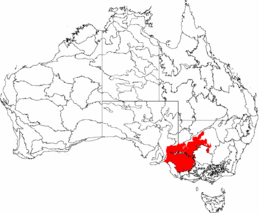Murray Darling Depression facts for kids
Quick facts for kids Murray Darling DepressionMurray-Darling woodlands and mallee |
|
|---|---|

|
|

The IBRA regions, with Murray Darling Depression in red
|
|
| Ecology | |
| Realm | Australasian |
| Biome | Mediterranean forests, woodlands, and scrub |
| Borders | |
| Geography | |
| Area | 197,900 km2 (76,400 sq mi) |
| Country | Australia |
| States | New South Wales, South Australia, and Victoria |
| Conservation | |
| Conservation status | Critical/endangered |
| Protected | 31,000 km² (15%) |
The Murray Darling Depression is a large natural area in southeastern Australia. It's also called the Murray-Darling woodlands and mallee. This region is a flat, wooded plain. Australia's two biggest rivers, the Murray and the Darling, flow through it. This area is important for many unique plants and animals.
Contents
Where is the Murray Darling Depression?
This area has a dry climate, like places around the Mediterranean Sea. The southern parts get about 400mm of rain each year. The northern parts are drier, with only about 250mm of rain. Hot, dry summers mean that bushfires are common here.
Plants of the Murray Darling Depression
The original plants in this area were mostly mallee eucalyptus woodlands. Mallee trees are a type of eucalyptus that grow many stems from the ground. Along the riverbanks, you would find thicker forests of black box (Eucalyptus largiflorens) and river red gum (Eucalyptus camaldulensis) trees.
Sadly, most of these original forests have been cut down. This was done to make space for growing wheat and for animal grazing. The plants that still grow here must be able to regrow after long summer dry spells and fires.
Animals of the Murray Darling Depression
This region is home to many interesting animals. You can find large numbers of lizards and ants here. Many types of honeyeater birds also live in this area. These include birds from the Lichenostomus and Meliphaga groups.
Lizards and Ants
Lizards found here include different kinds of skink. Some common skink groups are Ctenotus, Egernia, and Lerista. Ants are also very common. You might see Iridomyrmex ants, carpenter ants, and Melophorus ants.
Endangered Birds
Some special birds in this area are in danger of disappearing. These include the black-eared miner (Manorina melanotis). Another endangered bird is the malleefowl (Leipoa ocellata). These birds need our help to survive.
Protecting the Murray Darling Depression
In the past, a lot of the natural land in this plain was cleared away. Today, how land is used is more carefully managed. Some large areas of natural plants are now protected.
One important protected area is the Ngarkat Conservation Park - Big Desert Wilderness Park. This park is located on the border between South Australia and Victoria.
Current Threats to Habitats
Even with protection, there are still dangers to the natural homes (habitats) of plants and animals.
- Introduced weeds: Plants that don't belong here can take over and push out native plants.
- Salty rivers: Too much water is taken from the rivers for farming. This makes the remaining river water saltier, which harms plants and animals.
- Too much fire: Sometimes, fires are used too often to clear dry shrubs. This can prevent forests from growing back properly.
- Overgrazing: Animals like goats and rabbits, which were brought to Australia, eat too much of the plants. This leaves less food for native animals.
34°10′S 142°13′E / 34.167°S 142.217°E

